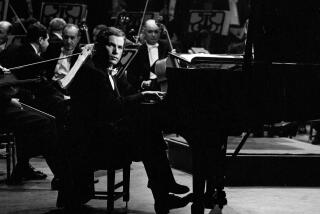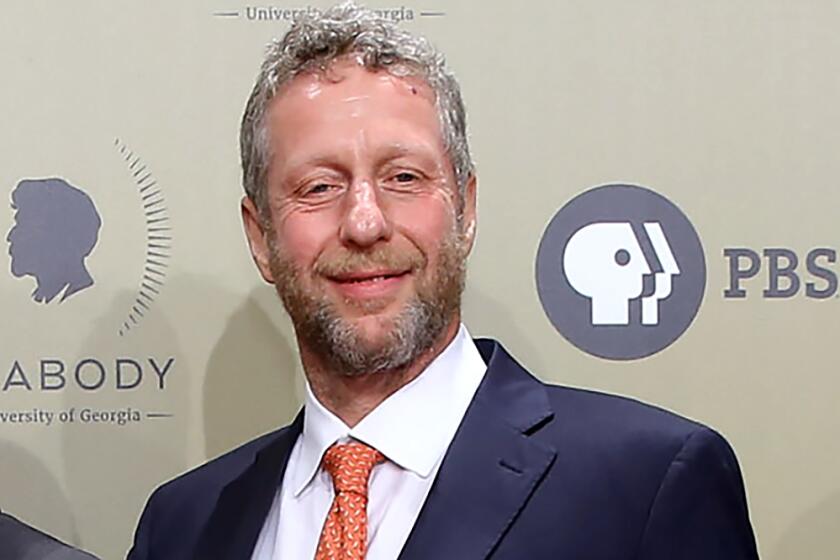Critic’s Notebook: Who really owns Gershwin?
“Who says that only Americans know how to play Gershwin?” asks Gramophone magazine this month as it hails a new Gershwin CD from the Leipzig Gewandhaus, the German orchestra that calls itself the world’s oldest. “By this time possibly nobody,” the British record guide answers its rhetorical self.
But if you ain’t got that swing ....
The Leipzigers’ new recording of “Rhapsody in Blue” and the Piano Concerto in F features the ancient orchestra’s current music director, Riccardo Chailly, and pianist Stefano Bollani. Both are Italian. The playing from ensemble and soloist is lovely. The jazziness comes across, depending on your fondness for foreign accents, as fetchingly feisty or as conveying a faint whiff of condescension.
We also have a recent recording of “Porgy and Bess” from Austria conducted by Nikolaus Harnoncourt, the once-controversial leader of the Vienna chapter of the early music period-instrument movement back in the ‘60s and now lionized all-around conductor. A few months before his 80th birthday, Harnoncourt realized a lifelong wish of performing “Porgy,” which he calls an American “Wozzeck,” at a 2009 summer festival in Graz. The recording of that concert performance shows that he means it.
So who really owns Gershwin? An American might answer: Leonard Bernstein, André Previn, Oscar Levant, Duke Ellington, Michael Tilson Thomas, Miles Davis, Earl Wild, Fred Astaire, Sarah Vaughan, William Bolcom, James Levine, Marcus Roberts and Audra McDonald.
Transition?
But the matter of Gershwin entitlement is obviously not a simple dispute. Schoenberg played tennis with Gershwin when they both lived in L.A. and thought him like a son, different as their music, temperaments and tennis were. Other great European composers — Berg, Stravinsky and Ravel, in particular — felt affection for Gershwin and his music (and, perhaps, a touch of jealousy for his bank account). And Gershwin picked up important compositional pointers from them (as they continued to eye his bank account).
Old World musical legends — Heifetz, Richter, Toscanini, Klemperer, the wonderful Hungarian pianist György Cziffra — knew how to play Gershwin. Their way. Klemperer may have sounded to be slumming when he memorialized Gershwin as an American Offenbach, but Richter turned Gershwin into a gripping American Prokofiev, and Cziffra’s “Rhapsody in Blue,” recorded in Budapest in 1955, is intriguingly Lisztian. These days, British conductor Simon Rattle and French pianist Jean-Yves Thibaudet are generally credible straight-ahead Gershwin enthusiasts among the Europeans.
Geography may not be everything, but it does help shape us. Born in Brooklyn, Gershwin found fame in New York and moved to Los Angeles at the end of his short life. And growing up in a show business-soaked environment can make Angelenos identify with Gershwin in the way Viennese do with Mozart and Schubert or Parisians with Debussy and Ravel.
But more than that, those great American musicians listed above are likely to have shaped our broader musical values. I, for instance, loved it when Bernstein went to Vienna in the ‘70s to conduct Beethoven and teach its Philharmonic the proper way to play Mahler, exaggerating the Jewish elements in the scores as an interpretive wake-up call.
Tilson Thomas’ Tchaikovsky — filtered through his L.A. youth working with Heifetz at USC and growing up around Stravinsky — offers a context that Russian-raised conductors lack. It was thanks to Previn programming Vaughn Williams with the Los Angeles Philharmonic, not recordings from the Brits, that I fell in love with these very British symphonies.
If we don’t, however, demand “authenticity” from Americans and appreciate that new layers might be revealed from different points of view, obviously we must grant other cultures the same license with Gershwin. Plus Gershwin was anything but stylistically stuffy himself. He wrote songs to be given individual character by individual performers, or “covered” as we would say now.
To further complicate the issue, we have a trove of Gershwin’s own recordings, which show a rhythmic unflappability and unostentatious quality of accenting that we call swing. But Bernstein could swing too while exaggerating almost everything he touched, whether blowing up the symphonic side of Gershwin or shimmying obscenely on the piano bench when he played the “Rhapsody.”
That leads to the most important question of all about Gershwin interpretation: What is swing? And it is the one with no proper answer. Swing, like sex, loses its essence in explanation. In fact, swing maybe is sex. And like sex, national and ethnic differences do matter, even if all cultures procreate. Harnoncourt and Chailly address swing specifically in the booklets accompanying their Gershwin CDs.
A relative sent Gershwin scores to Harnoncourt’s family in Germany during the ‘30s, when this music was officially considered decadent. The songs fascinated him, as did the illustrations of naked women that accompanied the sheet music. As a cello student, he writes, he was chastised for his freeness.
Yet freeness is exactly what Harnoncourt objects to in the “Porgy” performance tradition. He accuses the Russian-born conductor Alexander Smallens, who premiered “Porgy,” not only of cutting all the operatic material out of the first recording of the opera, leaving just hit tunes, but also of neglecting every one of Gershwin’s tempos and the dynamics in the score.
As other conductors have done, Harnoncourt restores the operatic material, but with more nuance. He accepts some of Gershwin’s own cuts when he feels that makes musical sense. He also restores Gershwin’s tempos and dynamics. He strives for rhythmic precision and a crystalline clarity of inner voices, all of which produces an antiseptic Gershwin sound.
Most of the singers (Jonathan Lemalu is Porgy and Isabelle Kabatu is Bess) are fully operatic, verging on overblown, yet the performance remains fascinating in its extreme classicizing. It is almost as though one enters Gershwin’s workshop, listening to the whirring of his mind.
In the last scene, Harnoncourt restores a “Symphony of Noise,” with bird song, percussion and the sound of the sea, which makes Gershwin for a moment sound outright Cagean — at least until the percussion starts tinkling out themes from the opera. What Gershwin might have accomplished had he lived beyond his 38 years boggles the imagination.
But I wonder how much of this recording is wishful historical thinking on Harnoncourt’s part, and it also brings into question the whole idea of authenticity. If an opera less than a century old by a composer whose performance style is well documented can be so unidiomatic and, ultimately, unhistorical, what does that tell us about Harnoncourt’s — or any other early music specialist’s — performances of much older works? Harnoncourt’s Gershwin is Harnoncourt’s Gershwin, as is his Bach, which doesn’t swing either.
Chailly grew up playing drums in a rock band as a youth in Milan and is intrigued by what he sees as a Stravinskian quality in the concertos. He further complains that Gershwin “is one of those composers who have suffered the most interpretive abuses, like Puccini, like Rachmaninoff.” For Chailly, the wrong approach is “going for extremes of interpretation.” Like Bernstein?
Still, that doesn’t stop his pianist from adapting a Puccini way of phrasing, with extremes of rubato that Bollani maybe mistakes for American swing. It works, inasmuch as Bollani is musical and has a lovely tone and a fine sense of flow. But he is also a silly pianist. In the “Rhapsody,” he attempts a tiny bit of improvisation, and the big Puccinian tune takes on an ice-cream truck jingle.
Chailly returns to the original jazz-band version of the “Rhapsody,” which has become a common practice, and his Stravinsky approach assures the performance’s rhythmic alacrity. But when German musicians let down their hair, it remains perfectly, risibly combed. A gorgeously rich violin solo sounding as if it belonged in “Ein Heldenleben” had me laughing out loud.
Americans, though, don’t dare become sanctimonious. This may not be our Gershwin, but it is Gershwin, played with love and care and imagination. We continue to hold a cultural deed on the composer, but that doesn’t mean that we can automatically be counted on to take the best care of his music or keep it fresh. Last year’s most hyped Gershwin release was the embarrassingly all-American yet musically incompetent “Brian Wilson Reimagines Gershwin.”
On the other hand, the Europeans, like it or not, really do re-imagine Gershwin.
More to Read
The biggest entertainment stories
Get our big stories about Hollywood, film, television, music, arts, culture and more right in your inbox as soon as they publish.
You may occasionally receive promotional content from the Los Angeles Times.







